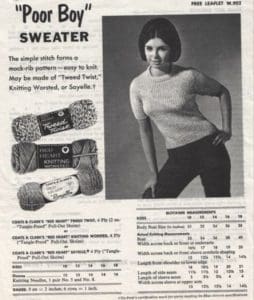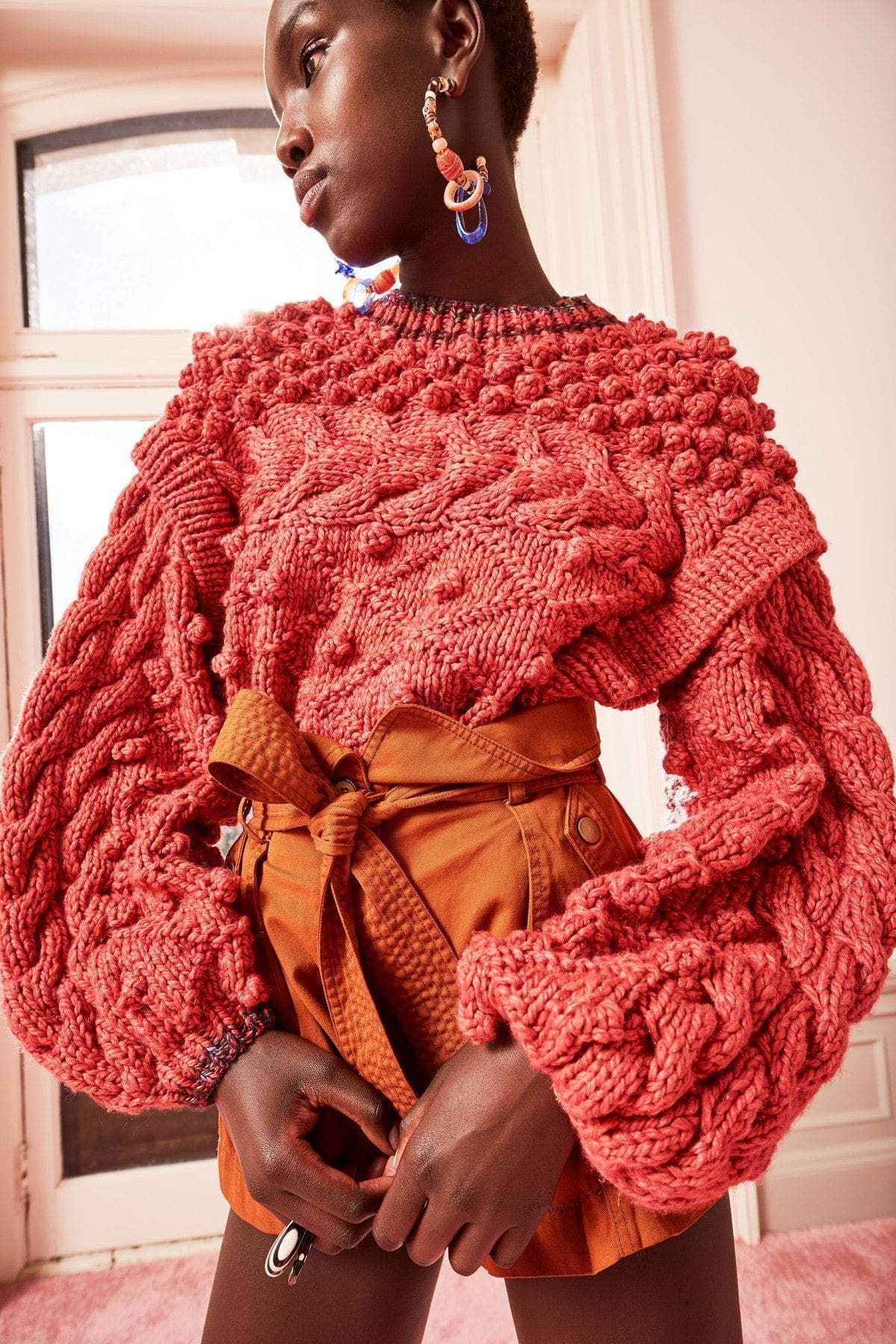knitwear has expanded into a revolutionary industry that is classified within the high fashion category. The first obvious sign of knitwear changing its role from functional to fashionable, occurred during the latter part of the 19th century and the early part of the 20th century, and since then knitwear has never looked back. Knitting remained a useful skill for people with limited resources or disabilities in order to earn income. Its associations with housewives became more pronounced after the world wars and Great Depression, when women were encouraged to knit for the war effort, or turned to knitting and mending out of necessity; knitting still maintains connotations with the familial structures, gender roles and tastes of women who embraced it long ago.
The changing roles of knitwear:
The first obvious sign of knitwear changing its role occurred during the latter part of the 19th century and the early part of the 20th century. Important developments occurred in English dress that changed the role of knitwear forever. Men’s dress shifted from tights to trousers, obviously having a significant impact on the knitted hosiery industry. The knitters were forced by the change in fashion trends to diversify into new markets.
By 1910 knitwear was established as an item of fashion in the modern women’s wardrobe, the idea of knit to fit (i.e. the concept of fully-fashioning) was completely accepted in social circles. During the same period of innovation, there were significant developments in circular knitting machines, which led this method of production replacing the frames production of half-hose and socks.
New styles of underwear, such as the union suit immerged (men’s under vest and pants). The new styles of the era “raglan sleeves” first appeared around 1912 generating trends in hand knitting, this was acknowledged as a well fitting style line and even today remains popular. There was also the controversial development of “cut and sew” knitwear, which caused immense unrest in knitwear manufacture.
Technology advancing towards complete garment production:
It was reported that during the 1995 ITMA exhibition in Milan, knitting technology came of age. The technology became more accessible and more responsive to new ideas and was demonstrated through fashion designers, increasingly exploiting the technology of knitting within their collections.
More features were made of seams i.e. the style lines became prominent features. However, the most noticeable influence of modern technology within fashion is that shaped garments have become mainstream fashion utilizing predominantly acrylic yarns, to create less expensive garments with that hallmark of quality.
Due to advanced technical developments during the 90s; Shima SES Compact digital machines capable of producing fully-fashioned pieces knitted sequentially and SES 122RT with its extra set of small needlebeds positioned above the normal knitting area to facilitate the knitting of shaped ribs, quality knitting was no longer limited to the elitist traditional manufacturers.
This was very much apparent with all the talk of complete garment production during the 90s and by 1995 Shima had satisfied this speculation by launching its revolutionary first generation of Wholegarment machines (SWG-X and SWG-V). Hence, providing shaping knowledge to an open market. According to Shima, the whole garment technology within fashion has been evolutionary rather than the predicted revolution.
There were many technological breakthroughs in the knitting machinery within the millennium period, the importance of the technologies influence/partnership with design was demonstrated in the first International Knitting Machinery Exhibition (IKMA) held late 2003 in Milan. This was the knitting industry breaking away from the prestigious long running general textile fair (ITMA) signifying the growing strength of this method of textile manufacture and its stand alone status both in terms of textile fabrics and design innovation.
Knitting and Fashion:
Like most things in the world of high fashion, knitting has fallen in and out of favour over the course of the 20th Century. Coco Chanel, who incorporated knits into her signature suits, also emphasised knitwear as ideal for recreational activities like sailing or sports. Sweater sets and A-line skirts, designed by the likes of Emilio Pucci and Missoni, characterised the 1950s and ’60s, and designers including Yves Saint Laurent, Sonia Rykiel, Calvin Klein, Liz Claiborne and Diane von Furstenberg have used knits regularly in their collections since, furthering its associations with either affluence and preppiness or ease. For most of the 20th Century, knitwear was used in clothing that was relatively conventional, although towards the end of the century, pioneers like Vivienne Westwood, Alexander McQueen and Julien Macdonald began using knits in unusual ways and to create edgier garments, expanding the applications of the technique.

Designers, artists and hobbyists have taken this to an extreme since the turn of the century. Knit-centric, fashion-forward designers like Yan Yan and Hazar Jawabra gaining traction around the world and actively reversing preconceived attitudes. “Because it still has these stereotypes of the domestic, mundane and tedious attached to it, when those are subverted, the effect is very powerful. The art of extreme knitting has really hit people in the face,” says Sandy Black, professor at the London College of Fashion who also curated a show for the Fashion and Textile Museum called Visionary Knitwear. According to Black, knitting is often still perceived as an amateur and uncomplicated craft, and the difficulty of the skill is chronically underestimated by people both and in and out of the fashion industry.
The boom has similarly boosted millennial-focussed companies that sell knitting tools and kits. The UK’s self-proclaimed “digital first” company Wool and the Gang has also seen a dramatic spike in sales because, they say, people simply have more free time to make things by hand. But knitting offers more than a sustainable way to be more self-sufficient and creative; it also benefits overall health and wellness. “Crafting is proven to reduce stress and anxiety, something we could all have a little help with right now. Sitting down to stitch can put you in an almost meditative state, we don’t say knitting is the new yoga for nothing!” says Anna Veglio-White of Wool and the Gang.
Sonia Rykiel is among the big-name designers who specialise in knitwear. She created the Poor Boy Sweater, which was featured on the cover of French Elle magazine. Her knitwear designs and new fashion techniques led her to be dubbed the “Queen of Knits”. The Sonia Rykiel label was founded in 1968 upon the opening of her first store, making clothing, accessories and fragrances.

Currently there are many emerging designers in knitwear industry who come up with something unique and ofcourse with various patterns in knitting. Creators merging age-old methods with innovative attitudes are helping reshape widespread attitudes about who knitting is for – and what it signifies.
Conclusion:
Knitwear has demonstrated throughout the ages that it can swiftly adapt to change in demand and the many trends of fashion. With the continuous up gradation in knitting machinery and designers exploring and creating various styles in knits, this trend will keep going ahead without it being out of style. Technology is providing a valuable tool for design, and fashion would do well to recognise the valuable contribution of innovative technicians and designers who have been the facilitators of knitwear’s repositioning in history from functional to fashionable clothing.
Reference:
George, C. (n.d.). Retrieved from https://www.bbc.com/culture/article/20200630-how-knitting-became-cool
https://textiles.ncsu.edu

